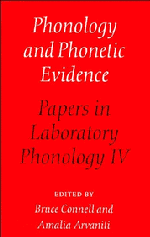Book contents
- Frontmatter
- Contents
- List of contributors
- Acknowledgments
- 1 Introduction
- I Features and Perception
- II Prosody
- III Articulatory Organization
- 15 Prosodic patterns in the coordination of vowel and consonant gestures
- 16 “Where” is timing? Comments on Smith
- 17 Asymmetrical prosodic effects on the laryngeal gesture in Korean
- 18 On a gestural account of lenis stop voicing in Korean: comments on Jun
- 19 A production and perceptual account of palatalization
- 20 An acoustic and electropalatographic study of lexical and postlexical palatalization in American English
- 21 What do we do when phonology is powerful enough to imitate phonetics? Comments on Zsiga
- 22 The influence of syntactic structure on [s] to [∫] assimilation
- 23 Assimilation as gestural overlap: comments on Hoist and Nolan
- 24 Orals, gutturals, and the jaw
- 25 The role of the jaw — active or passive? Comments on Lee
- 26 The phonetics and phonology of glottalized consonants in Lendu
- 27 Lendu consonants and the role of overlapping gestures in sound change: comments on Demolin
- Subject index
- Index of names
- Index of languages
16 - “Where” is timing? Comments on Smith
Published online by Cambridge University Press: 03 May 2011
- Frontmatter
- Contents
- List of contributors
- Acknowledgments
- 1 Introduction
- I Features and Perception
- II Prosody
- III Articulatory Organization
- 15 Prosodic patterns in the coordination of vowel and consonant gestures
- 16 “Where” is timing? Comments on Smith
- 17 Asymmetrical prosodic effects on the laryngeal gesture in Korean
- 18 On a gestural account of lenis stop voicing in Korean: comments on Jun
- 19 A production and perceptual account of palatalization
- 20 An acoustic and electropalatographic study of lexical and postlexical palatalization in American English
- 21 What do we do when phonology is powerful enough to imitate phonetics? Comments on Zsiga
- 22 The influence of syntactic structure on [s] to [∫] assimilation
- 23 Assimilation as gestural overlap: comments on Hoist and Nolan
- 24 Orals, gutturals, and the jaw
- 25 The role of the jaw — active or passive? Comments on Lee
- 26 The phonetics and phonology of glottalized consonants in Lendu
- 27 Lendu consonants and the role of overlapping gestures in sound change: comments on Demolin
- Subject index
- Index of names
- Index of languages
Summary
Caroline Smith's main points
At the heart of Smith's (henceforth CS) study is an attempt to describe rhythm adequately in an Articulatory Phonology framework. Two models of vowel and consonant organization are investigated, and CS suggests that these models of gestural coordination may give rise to timing patterns traditionally described as syllable- and mora-timing. If the primitives of phonological statement are gestures, then a gestural understanding of syllable- vs. mora-timing is important, since it helps to make it clearer how a purely gestural definition of “syllable” or “mora” (i.e. one in terms of the primitives of the statement) could be given. Some durational characteristics of rhythmical pieces apparently fall out from the articulatory model. CS's work makes a useful contribution to Articulatory Phonology in exploring the different possible timing relations that can hold between gestures of different types and in relating these to rhythm more generally.
The relationship between consonants and vowels may be more complex than just linear sequencing. Different organization of consonant and vowel gestures in relation to one another gives rise to syllable- vs. mora-timing.
Syllable-timing, as exemplified by Italian, has vowels coordinated with one another and consonants overlaid on to the vowels. CS calls this “vowel-to-vowel timing”, and it seems to be an instantiation of Fowler's (1980) coproduction model. In mora-timing on the other hand, as exemplified by Japanese, consonants are coordinated with vowels and vice versa. CS calls this “combined consonant-and-vowel timing.” Observable differences in vowel duration.
- Type
- Chapter
- Information
- Phonology and Phonetic EvidencePapers in Laboratory Phonology IV, pp. 223 - 234Publisher: Cambridge University PressPrint publication year: 1995
- 2
- Cited by



